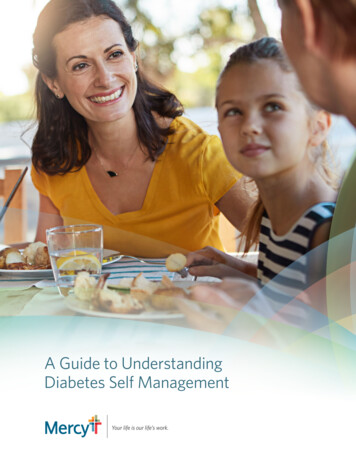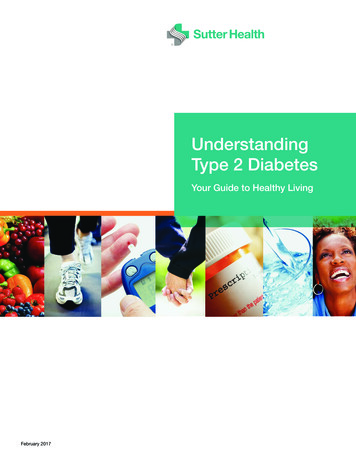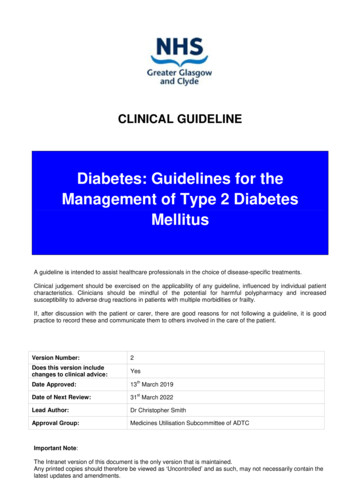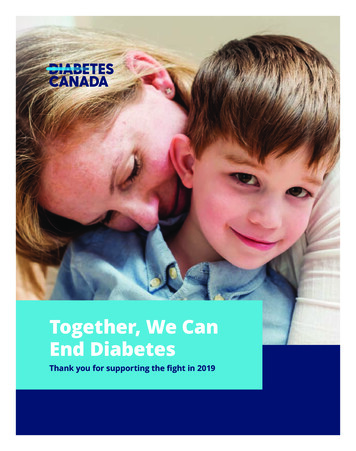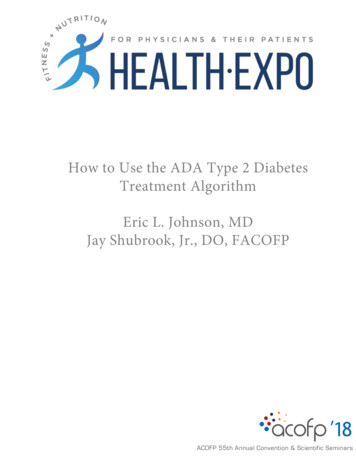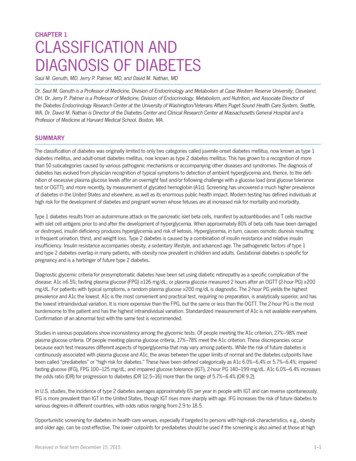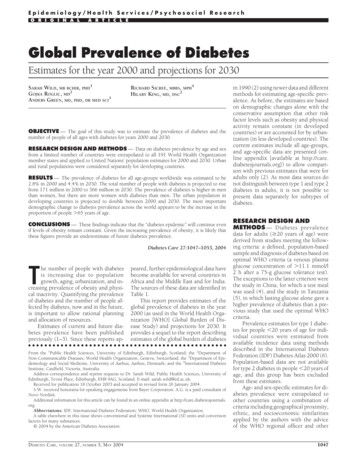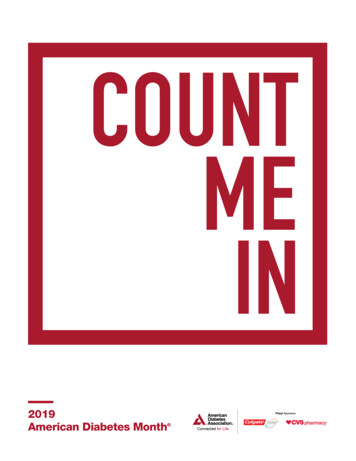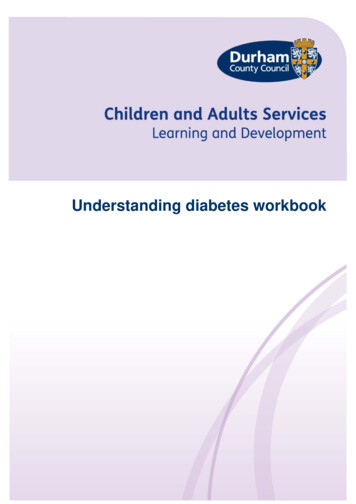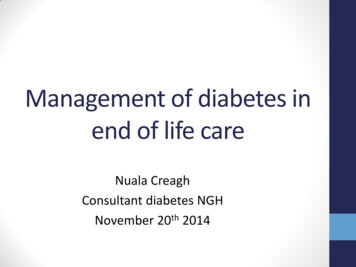
Transcription
Management of diabetes inend of life careNuala CreaghConsultant diabetes NGHNovember 20th 2014
Outline of talk Epidemiology A case Is there an evidence base? National guidance Local guidelines for glycaemic management
National diabetes audit data 2012- 2013
Prevalence of diabetes in palliative care setting 27% diabetes in 3yr retrospective survey of 563 patients 80% patients cancer, 20% other severe chronic disease No difference in survival Increased BMI and days in hospital Significant impact on health care burdenDionisio et al Am J Palliative Care 2014
84 yrs male – first admission PMH Type 2 DM Hypertension on ramipril Drugs gliclazide 160mg bd, metformin 1 g tds, pioglitazone 30mg od Ramipril 10mg od, nifedipine Simvastatin and aspirin Presentation with anorexia, weight loss, anaemia Diagnosis: Gastric cancer with liver metastases
Management and Progress Transfused Omeprazole instituted No other changes to medications BP 110 – 140 systolic BGs 8 -10 Discharged day 7 for discussion at UGI MDT
2nd admission 5 days later Found unconscious by daughter – BG 1.3 in A E HbA1c 95mmol/mol Gliclazide stopped on admission Gliclazide 80mg daily reinstituted before dischargebecause BGs rising to 28mmol/L Discharge plans to GP: ‘To monitor his BMs when ableplease’
3rd and final admission – 1/12 later Hypoglycaemic coma, prolonged Acute renal failure GCS 3 No improvement with iv glucose at 24 hrs Treatment withdrawn
Is there an evidence base? No large observational studies or RCTs Current knowledge based on expert opinion, surveys andretrospective studies Clinical recommendations derived from these Need for prospective studies
Common diabetes problems in end of life care Hypoglycaemia Hyperglycaemia, including steroid induced Adverse effects of medications eg metformin Withdrawal of medications in last few days of life
Expert opinion and clinicalrecommendations Hypoglycaemia is the main metabolic threat Glycaemic control should be relaxed – in order to avoidsymptomatic hypoglycaemia Insulin should be continued in type 1 diabetes, togetherwith regular glucose monitoring, as long as the patient isconscious. Communication between different HCPs caring for dyingpatients with diabetes needs to be improved
Blood glucose monitoring in end of life careAgainst Futile Invasive PainfulFor Useful screening test fortreatable symptoms No more invasive thanother procedures Glucose monitoring notoverly burdensomePikey et al, J Palliative med 2012
Palliative care and type 2 diabetes:a need for new guidelines? Diabetes patients in Palliative care units managedaccording to standard guidelines International recommendations for tight glucose control Have no scientific basis in end-of-life population Time for therapeutic effect life expectancy of patient Go against quality-of-life goals Discomfort caused by insulin injections, frequentglucose monitoring, hypoglycaemic episodesVandenhaute, American Journal of Medicine 2010
ABCD position statement on diabetes andend of life care 2011 Care of dying patient with diabetes had been neglected Need for diabetes MDT to liase with EOLC services Frequent glucose monitoring and complex insulinregimens should be avoided Avoidance of long term complications an irrelevant goal Patients and carers may need sensitive counselling reshift in glycaemic targets
ABCD 2011 – Glycaemic goals To avoid symptomatic hyperglycaemia Thirst Dehydration Confusion Drowsiness To avoid symptomatic hypoglycaemia
Factors predisposing to altered glucosecontrol at the end of lifeHyperglycaemia Stress response tosevere illnessHypoglycaemia Anorexia Weight loss Steroid therapy Co-existent infection Renal and or hepaticfailure
ABCD recommendations 2011 Avoid symptomatic hyper- and hypoglycaemia Minimum blood glucose monitoring Target blood glucose range 5 -15mmol/L Detailed treatment algorithms best avoided Early involvement of the specialist diabetes team forindividualised advice
Type 1 diabetes A disease of absolute insulin deficiency: insulinwithdrawal will lead to death Continue treatment with a simplified regimen wherepossible, unless patient specifies otherwise Twice-daily fixed insulin mixtures (Humulin M3, Humalog Mix 25) Twice-daily isophane (Humulin I or Insulatard) Once daily long- acting insulin analogue (Lantus or Levemir)
Type 2 diabetes Insulin treated may be able to discontinue insulin If reintroduction needed simple regimen such as oncedaily analogue (Lantus etc) or twice daily isophane(Humulin I etc) Tablet treated patients may be able to discontinuetreatment Blood glucose monitoring should not be performedunless Plans to adjust treatment based on results Patient’s preference
End of Life Diabetes Care:Clinical Care Recommendations Oct 2013 Commissioned by Diabetes UK Steering group Co-Chairs i) Director, Institute of Diabetes for OlderPeople (IDOP)ii) Consultant diabetologist 2 x Nurse consultants in diabetes Professor of Diabetes nursing GPwSI Older people Aim to build on July 2008 DoH End of Life Strategy
Key Principles of Care 2013 Tailor glucose lowering therapy and minimise diabetesrelated treatment effects Avoid metabolic decompensation and diabetes-relatedemergencies Frequent and unnecessary hypoglycaemia Diabetic ketoacidosis Hyperosmolar hyperglycaemic state Persistent symptomatic hyperglycaemia Avoid foot complications in frail, bed-bound patients Support and maintain the empowerment of theindividual patient and their carers to the last possiblestage
Management goals – glucose control targets No published evidence for any particular glucose orHbA1c range Target ranges based on consensus:Aim 1 – no glucose level less than 6mmol/LAim 2 – no glucose level higher than 15mmol/L Patients may need explanation and reassurance rerelaxed targets
Tailoring medications in end of life diabetes careFour stages A- D A – Blue ‘All’ from diagnosis stable with year plusprognosis B - Green ‘Benefits’ DS1500 Unstable/Advanced diseasemonths prognosis C – Yellow ‘Continuing Care’ Deteriorating weeksprognosis D – Red ‘Days’ Final days/Terminal Care days prognosis
Recommendations for A – Blue ‘All’ fromdiagnosis stable with year plus prognosis Use of ACE inhibitors, ARBs, aspirin, statins should bereviewed In light of diagnosis and comorbidities Consider dose reduction or even withdrawal of some Review oral agents and glucose control targets Weight loss may mean reduced need for OHA orpotential to simplify regimens including insulin
Sheffield guidelines for management ofdiabetes during last few months of life1. Aim of treatment to avoid symptoms of hyper- andhypoglycaemia; BG targets 6 – 15mmol/L2. Treatment usually needs to be reduced3. Not necessary to aim for tight glucose control4. Dietary restriction should be avoided – but avoid largequantities of sugary drinks5. Important to understand views of patients and carers;if treatment stopped should not be misconstrued asmedical team having given up6. Each patient needs individualised treatment
Adjustment of oral agents, insulin and GLP1analogues in type 2 diabetes
Adjustment of oral agents, insulin andGLP1 analogues in type 2 diabetes (2) Increase hypoglycaemic treatments only if symptoms ofhyperglycaemia AND blood glucose 15mmol/L Increase gliclazide in steps of 40 – 80mg daily Increase insulin by 10% if BGs 15mmol/L, 20% ifBGs 20mmol/L If advice needed, ring diabetes nurse specialist on centrecover
Diabetes and steroid therapy for malignancy Steroids prescribed in ? 30 - 60% patients Steroid induced hyperglycaemia in 30% Diabetes incidence correlated with dose not duration ofsteroidsPikey et al, J Palliative med 2012
Management of diabetes during steroidtherapy for malignancyNICE guidance Test for DM before starting, at one month and then 3monthly Monitor people with existing diabetes more closelyABCD guideline - Oct 2014 Monitor BG daily if considered to be at risk of DM –obese, family history, ethnic origin
Sheffield guidelines for management of diabetesduring steroid therapy for malignancyHigh dose steroids Increase BG levels in people with diabetes Increase risk of developing DM esp if at high risk Typically raise BG levels later in the day after a morningdose, BGs falling overnightTest for diabetes Before starting steroids, at one month, then 3 monthly If suspicious symptoms arise
Sheffield guidelines for management of diabetesduring steroid therapy for malignancyIf blood glucose abnormal before starting steroids refer todiabetes nurse specialist for education and self glucosemonitoring
Sheffield guidelines for management of diabetesduring steroid therapy for malignancyEmergency management of steroid induced diabetes Consider admission if patient dehydrated or drowsy orvomiting Refer urgently for insulin if BG 25mmol/LElective management Diet – exclude sugary drinks Daily BGs if symptoms – pre evening meal if am dose Start gliclazide 80mg if BG 15 on am steroid, increasingto 160mg if BG remains 15mmol/L Start insulin eg Humulin M3 8 – 12 unit am if BGs don’tfall
Management of known diabetes during steroid therapyif osmotic symptoms and BG 15mmol/LIf diabetes well controlled on high dose steroids anticipateneed for reduction in doses of insulin/oral agents whensteroid dose reduced
Type 1 diabetes (likely if patient on insulinsince diagnosis or within 2 years) If anorexia, weight loss or hypos reduce insulin by 25%,monitor BGs and may need to reduce further but DONOT DISCONTINUE Many patients, esp those DAFNE trained, can selfmanage If intercurrent illness eg infection may need increasedinsulin doses Check urine for ketones if symptoms suspicious ofketoacidosis – if admit
Terminal phase – last few days of lifePractice points1. In Type 2 DM insulin and oral agents can usually bestopped2. BG monitoring should be kept to the minimumnecessary and targets relaxed to 7 – 17 mmol/L3. It is important to ensure clinical deterioration not dueto hyperglycaemia or hypoglycaemia4. Regular review of the patient and management plan isnecessary5. If death imminent may be appropriate to discontinueall monitoring and insulin6. If advice needed contact DSN (diabetologist or on callpalliative care team if out of hours)
Diabetes Management in the Last Few Days of Life
Management of Hypoglycaemia in the lastfew months of life Treat according to Sheffield Hypoglycaemia guideline Adjust oral agents/insulin as advised in Table Reduce or stop gliclazide if hypo Reduce if new renal impairment or liver dysfunction orif HbA1c 60mmol/mol
Would our guideline have prevented the fatalhypoglycaemic episode in the case? HbA1c 95mmol/mol on first hypo admission,gliclazide reduced from 160mg bd to 80mg od ? BG monitoring in the community – guidelineadvises check only if symptoms of hypo or hyper No advice re stopping ramipril – likely majorcontributor to AKI
Management of Hypoglycaemia in the lastfew months of life Need to identify patients at high risk Poor appetite/erratic eating Weight loss Impaired/deteriorating renal function Liver impairment/cancer Previous major hypo Educate patient/carers re hypoglycaemia Stop gliclazide if possible Consider switch to a gliptin if alternative treatmentnecessary
Conclusion Diabetes is one of the commonest comorbidities in endof life care The evidence base for diabetes management is veryweak Consensus supports relaxation of glucose control toavoid hypoglycaemia Prospective studies are needed to guide improvementsin diabetes care
Message from Mr Dorries Law now requires an inquest to be held if DOLS in placeat time of death Inquest with a jury needed if unnatural cause Fall Mesothelioma Need to report death to coroner if DOLS in place
Tailoring medications in end of life diabetes care Four stages A- D A – lue ‘All’ from diagnosis stable with year plus prognosis B - Green ‘enefits’ DS1500 Unstable/Advanced disease months prognosis C – Yellow ‘ontinuing are’ Deteriorating weeks prognos


